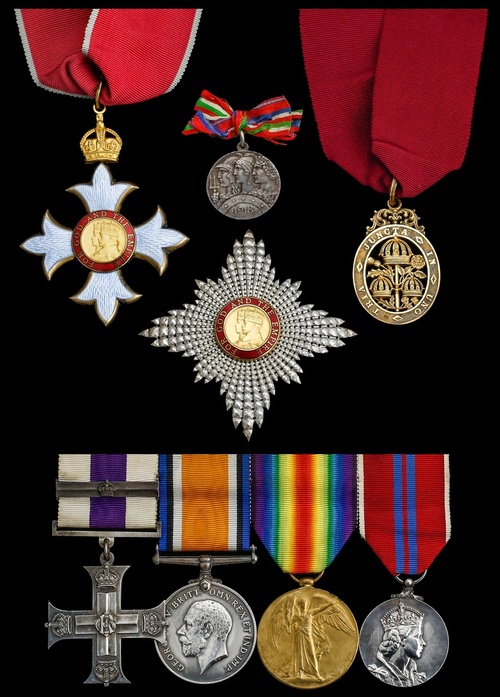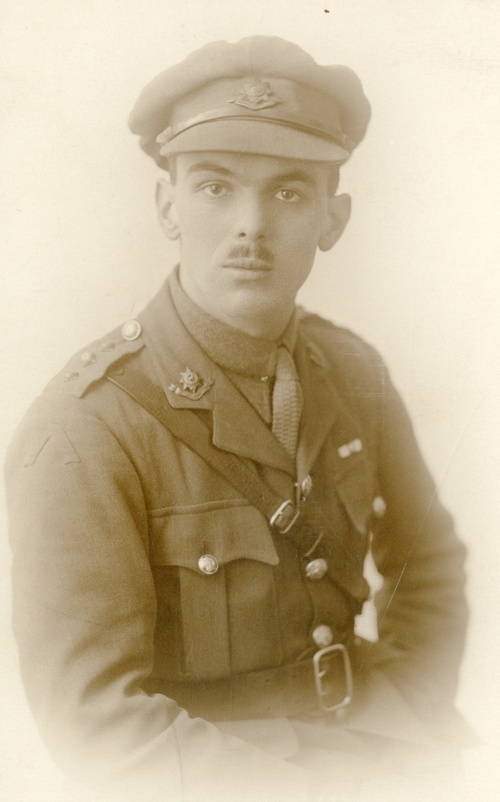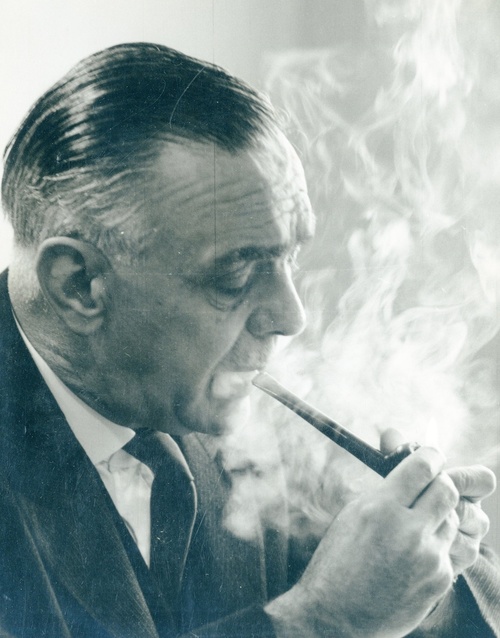Auction: 17003 - Orders, Decorations and Medals
Lot: 686
Sold by Order of a Direct Descendant
'Those who worked with him [at the Board of Trade] felt that he did more than any other man on the home front to contribute to the winning of the war. All the most significant controls over civilian goods other than food were invented and set out by him … Before the war was over his were the plans for winning the peace - such things as the Monopolies Commission and the Development Areas.
Short, bright-eyed, confidential voice, utterly un-pompous, with no vestige of the expected Civil Service aura of public school, university and club, Wattie had that essential of true leader - the capacity to inspire affection in all his staff and to make them all, cleaners and messengers upwards, feel themselves to be essential - and in that sense equal - parts of the job in hand.'
A glowing tribute sent by Sir Francis Meynell to The Times, 28 March 1974, refers.
A fine K.B.E., Second World War C.B., Great War M.C. and Bar group of seven awarded to Sir Laurence 'Wattie' Watkinson, who won high praise for his determined and courageous leadership at the Board of Trade in the last war: he then helped 'win the peace' as Deputy Secretary at the Ministry of Fuel and Power in the bleak and challenging years of 1947-55
As a young officer in the Great War he had displayed similar qualities in abundance, so much so that he won a brace of M.C.s in the space of three weeks in France in October 1918. Regimental records of 1/8th Battalion, Worcestershire Regiment, refer to swathes of enemy ranks falling to - or being taken prisoner by - his platoon or company. Thus 14 who were taken out in a hand-to-hand encounter during a trench raid and a pair of German officers who had the misfortune to run into him outside Pommereuil in October 1918: they 'put up a good fight but were killed'
The Most Excellent Order of the British Empire (K.B.E.), Military Division, Knight Commander's 2nd type set of insignia, comprising neck badge, silver-gilt and enamel, and breast star, silver and enamel, in its Garrard, London case of issue; The Most Honourable Order of the Bath (C.B.), Civil Division, Companion's neck badge, silver-gilt, hallmarks for London 1941, in its Garrard, London case of issue; Military Cross, G.V.R., with Second Award Bar, unnamed as issued, with its case of issue; British War and Victory Medals (Capt. G. L. Watkinson); Coronation 1953; Italy, Altipiani Medal, on original silk riband, mounted as worn where applicable, generally good very fine or better (8)
K.B.E. London Gazette 9 June 1949.
C.B. London Gazette 1 January 1944.
M.C. London Gazette 8 March 1919. Regimental records state:
'In the attack on Beaurevoir on 5 October 1918, he was in command of one of the leading companies, and by conspicuous gallantry and skilful leadership he gained his objectives and captured about 100 prisoners and two machine-guns. The commanders of the left and support companies being casualties, he took command of the situation and organised the defence of the east side of the village, at the same time regaining touch on both flanks.'
Bar to M.C. London Gazette 2 April 1919. Regimental records state:
'During operations on 23-24 October 1918, he showed great initiative and gallantry in commanding his company. He got through the enemy defences and arrived on the outskirts of Pommereuil, got into touch with a tank and successfully cleared part of the village, capturing a large number of prisoners. He then proceeded to his position near Bois L'Eveque and consolidated, capturing more prisoners. During operations on 24 October, he again did good work.'
(George) Laurence 'Wattie' Watkinson was born on 29 January 1896, the son of G. L. Watkinson of Battenhall, Worcestershire and was educated at Worcester Royal Grammar School.
Soldier
Having found employment as a civil servant at the War Office, he applied for a commission and was appointed 2nd Lieutenant in the 12th (Reserve) Battalion, Worcestershire Regiment in May 1915.
He subsequently joined the 1/8th Battalion in the Ypres salient in October 1917, but a week or two later he and his comrades were embarked for Italy. They saw action in the Piave operations and mounted several major raids. The unit's war diary describes how Watkinson led No. 2 Platoon, 'A' Company in just such a raid near Camporovere on the night of 8-9 August 1918: he and his men killed 14 enemy soldiers in a severe hand-to-hand encounter.
In the following month, the Battalion was re-embarked for the final push in France and it was here, in the fighting at Beaurevoir in early October 1918, that Watkinson won his first M.C.; his Bar was awarded for like deeds at the capture of Pommereuil at the end of the same month, when - in the temporary rank of Captain - he commanded 'A' Company in the face of heavy opposition. At one point in the action two enemy officers - one of senior rank - ran into Watkinson: 'These two officers put up a good fight, but were killed, and one of their orderlies escaped.' Watkinson then commandeered the services of a tank and cleared the village of the enemy.
Outstanding civil servant
On being released from service in January 1919, Watkinson returned to the Civil Service, initially with an appointment as a clerk in the Inland Revenue. He subsequently rose to Board level but in 1931 he transferred to the Board of Trade. It was in this capacity - as related in Sir Francis Meynell's glowing tribute to The Times - that Watkinson rose to prominence and high office, particularly in the nation's hour of need in the Second World War.
From 1940, he worked as Principal Assistant Secretary and was directly involved in a number of vital measures of war-time control, commencing with the limitation of the output of the consumer goods industries needed to release labour for war work, continuing with concentration of industry to release factory space for war purposes and, as supplies of consumer goods became scarcer, concluding with the various measures for rationing; in particular, clothes and furniture rationing. In 1942 he was seconded to the newly established Ministry of Fuel and Power to work on the Beveridge scheme for the 'points' rationing of the various forms of fuel, returning to the Board of Trade at the end of the year. He remained employed as Under-Secretary for the remainder of the war, concentrating on arrangements for post-war reconstruction, in which role he proved inspirational. He was awarded the C.B.
Following V.E. Day, he was concerned with the working parties set up by Sir Stafford Cripps to enquire into some fifteen of the consumer goods industries, ranging from cotton and clothing to carpets and cutlery, and much besides. However, he was transferred as Deputy Secretary to the Ministry of Fuel and Power in the fuel crisis of 1947, in which capacity he had to deal with the problems of the coal mining industry. He was appointed K.B.E.
Postscript
Watkinson subsequently served as Vice-Chairman of Harris Lebus Ltd. (1955-57) and as Chairman (1958-61). In the early to mid-1960s he acted as Chairman of the London Electricity Consultative Council and as a Member of the London Electricity Board. He was also a Member of the Monopolies Commission 1960-68.
Sir Laurence, who retired to Loughton in Essex, died in March 1974.
Sold with a quantity of original documentation and related artefacts, including:
(i)
A quantity of Great War period photographs, including nine portrait images of the recipient, one annotated, 'To Dollie. 30-9-15, Yours adoringly, Laurie.' - they were married in 1919; postcard photographs (5) of training at Glasgow, 1915, and Tidworth Camp.
(ii)
Fourth Army certificates for the award of the Military Cross and Bar, both dated 6 March 1919 and signed Rawlinson, Commanding Fourth Army; and a small card certificate to 'Captain G. L. Watkinson, M.C.', who 'Served with the 1/8th Battalion, The Worcestershire Regiment, on Active Service, from 11-X-1917 to 26.I.1919', signed by Lieutenant-Colonel H. Clarke.
(iii)
A Feldpostkarte addressed to recipient's father, and Field Service postcards (2) to Miss Doris Pilling, Blackpool, dated 22 October 1917 and 4 April 1918.
(iv)
Letter to the recipient's father, from William F. Baillie on behalf of the members of Baxter Church, Lorne St. Kidderminster, offering his congratulations - 'How much your hearts must have been cheered by these distinguished Honours.'
(v)
Home Guard Certificate in the name of 'George Lawrence Watkinson', who served from 24 December 1941 to 31 December 1944.
(vi)
An archive of letters (21), many from notable politicians and their wives, including examples from Hugh Gaitskell (2), on Ministry of Fuel and Power letterhead notepaper stating his appreciation of Watkinson's work; from Dora Gaitskell requesting advice on how to stop her husband overworking and the impact on her own public life - 'I have never acquired a strong taste for it … We are not moving into No. 11'; from Ernest Bevin (2), one dated 19 May 1952 and concerning the seriousness of the coal situation and the need for decision and action, the second a post-war letter of thanks; from Stafford Cripps and his wife Isobel (8), post-war era, wishing Watkinson a good recuperation and to 'get really fit - not by riding though'; and further letters from Philip Noel-Baker, regarding the coal crisis and the help Watkinson has been offering … 'I seem to be having a hard time in the House at present, and I can assure you that your assistance in providing information and above all your wise advice, have been of immeasurable aid in easing my burden.'
(vii)
A 'Personal and Confidential' letter from 10, Downing Street, Whitehall, dated 11 May 1949, informing Watkinson of his appointment as Knight Commander of the Order of the British Empire in the forthcoming Birthday Honour's list, in Central Chancery envelope; investiture tickets (2) in O.H.M.S. envelope; C.B. warrant and his Coronation Medal certificate.
(viii)
A quantity of post-war photographs (7), showing Watkinson at functions and at work.
(ix)
Newspaper and magazine cuttings relating to Wilkinson's role in the Second World War; appointment notices from The Times, noting Watkinson's role as Under-Secretary at the Board of Trade, 1942; articles relating to fuel rationing; award notifications and a Daily Telegraph article dated 24 July 1945, titled 'I thought it was good-bye.' This refers to his aircraft making a forced landing on an allotment at Edgware, Middlesex, whilst bound for a meeting of cotton leaders at Manchester. It seems the starboard engine of the Dakota cut out at 300 feet, causing it to 'belly land' in a small recreational park; sold with two photographs of the damaged Dakota.
(x)
Newspaper and magazine cuttings relating to his life and career post-war; including an article titled 'Furniture Boss tells of Good Year Ahead', relating to Harris Lebus furniture; and an article on the Duke of Edinburgh touring the Harris Lebus Works.
(xi)
Sweetheart brooches of the Worcestershire Regiment (3), two of circular form with silver inlay.
Please see Lot 637 for his miniature dress medals.
Subject to 20% VAT on Buyer’s Premium. For more information please view Terms and Conditions for Buyers.
Sold for
£2,600









